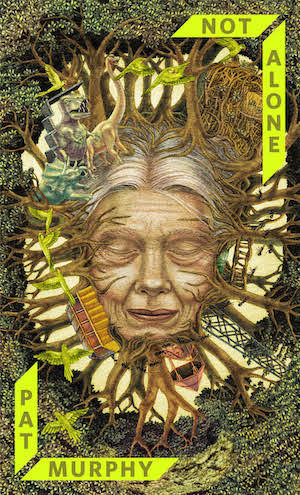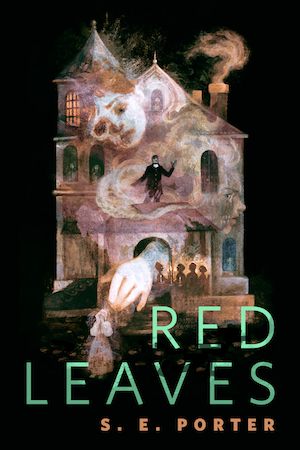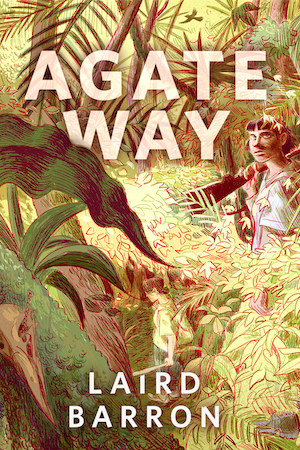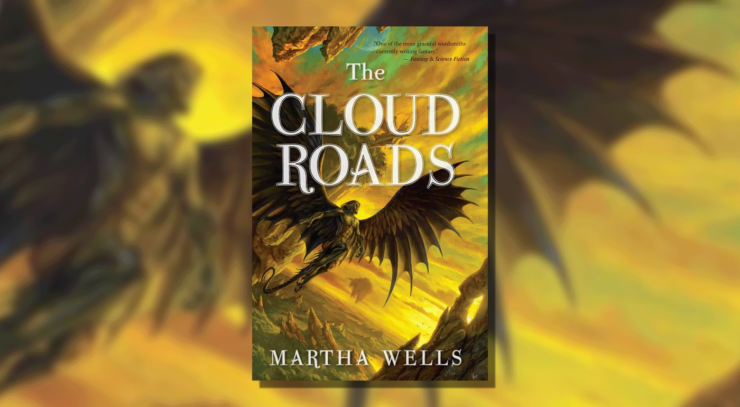Around the time The Cloud Roads first came out, 2011, I was just getting back into fantasy fiction after years in the lit fic mines. At the time, epic fantasy fiction tended to be cisallohet white guys in a faux-medieval European landscape deciding imperialism is a great way to do government, none of which held much appeal. Eventually, things started getting more diverse in speculative fiction, and it was easier to find different kinds of stories and characters I was interested in.
Like many folks, my first introduction to Martha Wells was Murderbot. All Systems Red is, to me, a perfect sci-fi novella, and the whole Murderbot Diaries series gets better and better with each installment. The way she builds worlds where diversity—in gender, race, ethnicity, queerness, and other identities—is the default mode instead of added flavor is exactly what I want in speculative fiction. I love how she engages with tropes even as she plays with or dismantles them. And her writing style is just plain fun. There’s a reason she’s so beloved in SFF. Between the diligent craftwork and the inclusive worldbuilding, her stories and characters are easy to fall in love with.
Cut to 2023 and the release of Martha Wells’ Witch King. By this point, I’ve been reading, engaging with, and critiquing speculative fiction and YA for more than a decade. I know what I like and avoid what I don’t. I checked out Witch King based solely on my love of the Murderbot Diaries. Lucky for me, it was everything I wanted in an epic fantasy novel, plus it changed my mind about some of the elements of epic fantasy I thought I didn’t like.
Inspired by Witch King, this year I decided to finally go back and read her oeuvre, starting with The Cloud Roads. And I’m bringing y’all with me. Starting this month until whenever I finish her bibliography, I’ll be covering one or two Martha Wells books per column. We won’t be doing chronological order, but I will try to focus on one series at a time.
The Books of Raksura spans a trilogy, a duology, and two short story collections, all set in a land known as the Three Worlds (for the land, sky, and sea, and all the creatures that live therein). We’ll get into it more in the discussion, but the short version is that the Raksura are a sort of human/dragon cross that can shapeshift into a humanoid form. Their main antagonists are The Fell, a much more violent version of the Raksura. The first trilogy is where we meet Moon, a Raksura with a tragic past and a wild destiny. Why start with The Cloud Roads? For one, the Books of Raksura series is highly acclaimed. For two, the similarities between Moon and Kai from Witch King were too tempting to pass up. And for three, the original trilogy seemed like the lowest barrier of entry for me personally. So let’s dig in, shall we?
“Moon had been thrown out of a lot of groundling settlements and camps, but he hadn’t expected it from the Cordans.” That single first sentence carries within it a whole world of information. In it we learn that this is a world closer to our ancient era rather than medieval Europe, and one where “human” isn’t a thing. “Groundlings,” as we later learn, are bipedal, sentient beings living in nomadic camps, sprawling cities, and everything in between. The creatures living in the air and sea are more animalistic, but can also be sentient. All that remains of the sentient skylings are their floating islands. Although vaguely human-shaped, groundlings can have skin, feathers, fur, oversized or undersized features, etc.
Technically groundlings, Raksura and The Fell (we’ll get to them) are the only ones that we know of who can fly. Raksura are comprised of two breeds, so to speak: the winged Aeriat and the wingless Arbora. Within those are several subcategories. Aeriat are warriors and leaders, such as warriors, queens, and consorts (who only marry and reproduce with queens). Arbora are laborers and artisans, such as teachers, mentors, hunters, and soldiers. Roles are determined not by skill or interest but by your body. One character, Chime, is forced to change roles when his body evolves into a different from mentor to warrior; however, this is extremely rare. For most Raksura, you are what you’re born—or so it seems.
That opening sentence also tells us a lot about Moon and the way he inhabits this world. Wells is great at character names and personalities. I mean, Moon? Come on! Perfect name. Moon is all alone in the Three Worlds. His family is dead, killed by predators called Tath. He spends his life finding temporary refuge in groundling settlements until someone discovers he can shift into his reptilian form, then he has to flee to the next settlement. Never setting down roots, never being his true self.
Both Moon’s wives (the Cordans practice polygyny) can tell he’s keeping secrets, and one decides to do something about it. After spying on him, she discovers Moon’s real identity…sort of. His mother died before she could tell him what species he is, and in all his travels he never encountered anything else that looked like him—except the Fell. We don’t know much about the Fell yet but whoever they are, they resemble Moon’s reptilian form enough that the Cordans assume he’s one of them.The Cordans are living in this small camp after their city was destroyed by the Fell, so they have every reason to be terrified of a winged reptilian dude with no family and no past. Thinking Moon is a sleeper agent trying to mind-control them (among the Fell’s many abilities, they can influence people into doing or believing things, often without them even being aware of the compulsion), they leave him to die outside the gates.
Fortunately, he’s rescued by Stone, an older guy who not only reveals to Moon that he’s actually Raksura but also offers to take him to his colony, Indigo Cloud. Unfortunately for Moon, being a loner isn’t seen as a good thing by other Raksura. All Moon wants is to figure out who he is and where he came from, but instead he gets dropped right into the middle of court politics. Moon, much like Murderbot and Kai, is both highly capable and out of his depth. He knows a lot about the things that keep him alive—how to hunt, how to hide, how to assimilate into groundling societies—and nothing about the Raksura’s complex and often highly emotional web of interpersonal relations that maintain social order. As it turns out, Moon is a consort, which means his entire purpose in the colony is supposed to be navigating relationships while being waited on hand and foot by everyone else. And breeding with the Queen to produce a royal clutch (baby Raksura).
It’s Moon’s arrival at Indigo Cloud that turned a good book into one I knew I would be obsessed with. Chime is the second Raksura to immediately take to Moon. Stone treats him almost like a nephew or a much younger brother, but Chime sees Moon as a potential friend and companion. As soon as the two of them met, the little shipping part of my brain started flashing warning lights. I can’t point to anything specific, but there was just an air of easy camaraderie and an undercurrent of flirtation that I found intriguing. By the end of this book, my headcanon was fully ensconced in Jade, Moon, and Chime all living together in a nest and raising their clutch. Just let me revel in coziness I’ll save my thoughts about this polyamorous relationship for the next read-along where I’ll dive into the other two books in the trilogy, but at this point in the first book, I was still under the assumption that Chime and Moon were never going to be A Thing. Remember, this book was published in 2011. Queer main characters weren’t all that common in epic fantasy back then, at least not in the books I was encountering. I wasn’t anticipating anything to come of my headcanon but OH MY GOD WAS I WRONG.
While at Indigo Court, queen-to-be Jade, wants to relocate her dying colony before they’re too weak to move while Pearl, her mother and current queen, refuses to budge. Moon gets on everyone’s nerves. A third of the court thinks he’s incompetent and rude, a third don’t trust him and want to run him out of Dodge, and a third think he’s probably not so bad once you get to know him. Pearl and Jade bicker over who gets to claim him as their consort, but Moon makes it clear he can’t be bought, traded, or manipulated. As he struggles to find his place, we learn more about his background and compounded traumas. Besides witnessing the slaughter of his entire family as a young child, as an adult he endured physical, psychological, and sexual abuse at the hands of the Fell. No wonder he finds it difficult to trust.
Stone gets the idea to borrow a flying boat from some groundlings who are distantly related to the floating island folks as a way to quickly transport the Arbora and the rest of the colony. Unlike the Cordans, these Islanders welcome the Raksura with open arms. Scholars and explorers by nature, they are eager to learn about their visitors. And Moon, who has spent a lifetime meeting new people and integrating into strange societies, is able to liaise between the Islanders and the Raksura. Grandfather Delin-Evran-lindel is the sweetest old man, just brimming with childlike curiosity and a refusal to act his age. I spent the rest of the book fretting over his safety, much like his grandson, the enjoyably grumpy Niran. As a side note, Delin is also the writer of the first of the two Appendices in the back of the book: excerpts from Observations of the Raksura: Volume Thirty-Seven of A Natural History (by Delin) and Additions to the List of Predatory Species (by Venir-Inram-Alil, who we haven’t met).
The way Wells does worldbuilding never fails to impress me. The Three Worlds feel realistic and lived in. We see different cultures and beliefs, each shaped by the geography and history around them. For example, while Stone and Moon are flying to Indigo Cloud in the beginning, they encounter a caravan of nomads called the Serican who ride on massive wagons and wear bells stitched into their clothes. Why bells? Who knows. It doesn’t matter why. That’s who they are and all we’ll ever know. That’s enough for me. I like having unknowns in the story. To quote the inimitable Iris DeMent, “I think I’ll just let the mystery be.”
Stone and co. secure the boats, but are harassed by the Fell (and their mind-controlled creatures) the whole way there and back. The more we learn about these two species, the more they seem like hornets versus honeybees. Or, as Stone puts it, “The place of the Raksura in the Three Worlds is to kill Fell.” Fell will kill and devour anything that crosses their path and have no culture of their own. Raksura think of them as barely more than animals, although we’ll learn that’s far from the truth. The Fell have set their sights on Indigo Court, and nothing will stop them from destroying it. When the Fell finally attack, they steal clutches of babies and children and slaughter countless other adults. Surprising everyone including himself, Moon joins the rescue team. In the Fell nest, they discover survivors from other conquests, including the last remaining royal clutch from another decimated court. A terrifying truth is discovered: Fell are intentionally targeting weakened courts to steal clutches and consorts in an attempt to breed hybrids, creatures with Raksura power and Fell brutality. The Raksura come out victorious, but at great cost, by the skin of their teeth, and only temporarily.
At the very end of the book, Moon agrees to become Jade’s consort, and not even a little begrudgingly. Trauma is a theme that pops up often in the Murderbot Diaries, and one that we see in Moon throughout this series. Trauma reshapes you, sometimes in ways that make things worse. Moon has never been somewhere long enough or safe enough to be able to process his trauma and figure out what kind of person he might become on the other side of it. What I see in Moon at the end isn’t just a person latching onto a position of privilege and power but of someone looking for a space where he can be himself. Jade could choose any consort from any court, Chime could choose anyone to be his companion, and Stone could have chosen any Raksura for the colony’s new consort, but all chose Moon. Moon has never had the freedom to choose—even the wives he had when we first met him were given to him by the Cordans. Choosing means committing. It means hope. It means sticking around. Is he ready to follow through with that?
I went into this project worried that Wells’ older books would be too much like all those other fantasy books from the late 2000s and early 2010s that bored me. In all honesty, I was afraid I would be disappointed. I didn’t want to pick up one of her older books and realize it was just Tolkein with the serial numbers filed off. I cannot fully express how happy I am that didn’t come to pass. I enjoyed The Cloud Roads way more than I expected to, and I hope this is a sign that there are even better things to come.
Join me next month when I’ll dive into The Serpent Sea and The Siren Depths.










